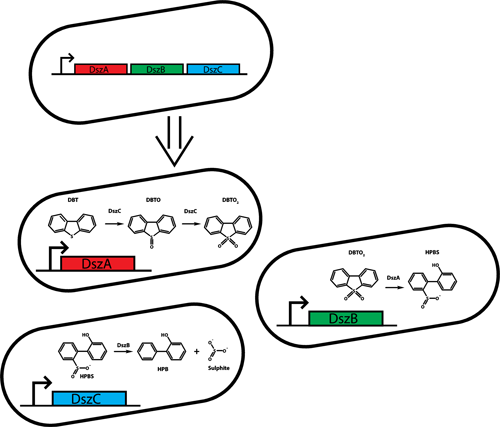Team:British Columbia/Desulfurization
From 2012.igem.org
| Line 4: | Line 4: | ||
[[file:Dsz_operon.png|640x480px|left]] | [[file:Dsz_operon.png|640x480px|left]] | ||
| - | == | + | ==The Dsz operon and Bio-desulphurization |
Once we are able to tune our biological consortium it was time to test it on a system of economic relevance: the desulfurization of dibenzothiophene (DBT). DBT is a polyaromatic sulphur compound present in oil crudes whose combustion by oil-powered machines, such as automobiles, causes the release of sulphur dioxide (SO2) into the atmosphere. Sulphur dioxide is a principle source of acid rain and air pollution, and thus the removal of this compound from oil crudes provides benefits to the air quality and general environmental health of developed areas. DBT is highly resistant to hydrodesulphurizaiton, the current process of removing sulphur compounds from crude oil, and thus novel methods of removing this compound are desired. Biodesulphurization of DBT is one means of removing such a compound. Specifically, the 4S pathway from Rhodococcus erythropolis DS-3, which utilizes the gene products of the Dsz operon, is ideally suited for such a task because it removes DBT from crude oil with minimal impact on the energy density of the crude (i.e. the desirable compounds in the crude that actually serve as fuel, are preserved). As a result of the 4S pathway, DBT is converted to hydroxybiphenyl (HPB, Figure 1).== | Once we are able to tune our biological consortium it was time to test it on a system of economic relevance: the desulfurization of dibenzothiophene (DBT). DBT is a polyaromatic sulphur compound present in oil crudes whose combustion by oil-powered machines, such as automobiles, causes the release of sulphur dioxide (SO2) into the atmosphere. Sulphur dioxide is a principle source of acid rain and air pollution, and thus the removal of this compound from oil crudes provides benefits to the air quality and general environmental health of developed areas. DBT is highly resistant to hydrodesulphurizaiton, the current process of removing sulphur compounds from crude oil, and thus novel methods of removing this compound are desired. Biodesulphurization of DBT is one means of removing such a compound. Specifically, the 4S pathway from Rhodococcus erythropolis DS-3, which utilizes the gene products of the Dsz operon, is ideally suited for such a task because it removes DBT from crude oil with minimal impact on the energy density of the crude (i.e. the desirable compounds in the crude that actually serve as fuel, are preserved). As a result of the 4S pathway, DBT is converted to hydroxybiphenyl (HPB, Figure 1).== | ||
Revision as of 07:53, 3 October 2012

==The Dsz operon and Bio-desulphurization
Once we are able to tune our biological consortium it was time to test it on a system of economic relevance: the desulfurization of dibenzothiophene (DBT). DBT is a polyaromatic sulphur compound present in oil crudes whose combustion by oil-powered machines, such as automobiles, causes the release of sulphur dioxide (SO2) into the atmosphere. Sulphur dioxide is a principle source of acid rain and air pollution, and thus the removal of this compound from oil crudes provides benefits to the air quality and general environmental health of developed areas. DBT is highly resistant to hydrodesulphurizaiton, the current process of removing sulphur compounds from crude oil, and thus novel methods of removing this compound are desired. Biodesulphurization of DBT is one means of removing such a compound. Specifically, the 4S pathway from Rhodococcus erythropolis DS-3, which utilizes the gene products of the Dsz operon, is ideally suited for such a task because it removes DBT from crude oil with minimal impact on the energy density of the crude (i.e. the desirable compounds in the crude that actually serve as fuel, are preserved). As a result of the 4S pathway, DBT is converted to hydroxybiphenyl (HPB, Figure 1).==
Why the Dsz operon?
We choose the Dsz operon for a number of reasons. As stated above, bio-desulphurization has the potential to help relieve serious environmental problem associated with DBT content of fossil fuels. However, the Dsz operon also has a number of advantages directly related to our consortium. First, the pathway has previously been expressed functionally in E. coli, allowing us to obtain a working copy of the pathway expressed in an E. coli monoculture (REF). This will let us directly compare the efficiency of the single cell pathway with our distributed metabolic network. Also, the availability of a working pathway in e.coli indicates that all of the required enzymes will be active when recombinantly expressed in our e. coli consortium strains. Finally, the desulphurization activity of the 4S pathway can be easily monitored and quantitated by HPLC analysis (REF).</br>
 "
"

